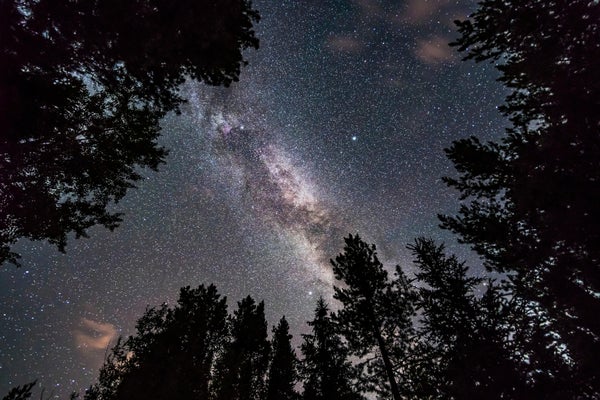Just before going to bed the other night, I was out walking my dogs. It was about 11 P.M., and, out of well-earned habit, I did what I always do: I looked up.
It was a clear night, and while my eyes hadn’t yet adjusted to the darkness, a few stars were already visible to me. I took a moment to get my bearings and then suddenly smiled with delight. Three bright stars were rising to the east: two closer to the horizon and one already high overhead.
“Oh, hey, hello there, Summer Triangle,” I whispered to myself. I was surprised to see the arrangement despite its appropriate name and the fact that this was early July. It had been cloudy around here for so long, I’d forgotten what stars were up.
On supporting science journalism
If you're enjoying this article, consider supporting our award-winning journalism by subscribing. By purchasing a subscription you are helping to ensure the future of impactful stories about the discoveries and ideas shaping our world today.
The Summer Triangle is as familiar to amateur astronomers as Orion or the Big Dipper. It’s comprised of three of the brightest stars in the sky—Vega, Altair and Deneb—which are so much brighter than the stars around them that they make the triangle a landmark, or rather, a skymark. It’s easy to spot: just go outside on a clear summer night and look east. In early summer, like now, Altair is roughly 30 degrees above the horizon, a third of the way to the zenith. Deneb is to its upper left, and Vega is higher up than both of them. Later on in the summer, all three are high in the sky by the time it gets dark.
But this asterism—literally, a pattern of stars—is not just a pretty sight. The stars that define it are amazing individually, too.
Vega, the brightest star in the constellation Lyra, is 25 light-years from Earth. It’s what’s called an A-type star—hotter and more massive than the sun. It’s 40 times more luminous than the sun, which is why it appears so bright. One of the few stars in the sky bright enough to have a noticeable color, it shines a sapphire blue.
It’s also young as stars go: less than half a billion years old. The sun has been around for well more than 4.5 billion years, so Vega is barely a toddler by comparison. Observations of Vega using the Infrared Astronomical Satellite in the 1980s found that it was emitting too much infrared light for a star in its class, and astronomers concluded it was surrounded by a debris disk. Such a disk forms during a step in planetary formation when rocky material is just starting to gather itself together. Giant asteroids collide in the disk and create dust that is warmed by the star and causes excess infrared glow. Vega was the first star seen to have a debris disk, and in that way, it’s sort of the grandparent of the field of exoplanetary science.
Altair is similar to Vega in that it’s also an A-type star and therefore hotter than the sun. It’s closer to us than Vega: only about 16 light-years distant. But it’s less luminous, shining “only” 10 times brighter than the sun, so it appears somewhat fainter by eye. It’s the brightest star in the constellation of Aquila, the Eagle.
What sets Altair apart from most stars is that it’s what’s called a rapid rotator, a star that spins rapidly—extremely rapidly. It takes less than eight hours for it to spin once! The sun takes a month to rotate once, and Altair is bigger, about twice the sun’s diameter, so material on its equator is screaming around at more than a million kilometers per hour. If it rotated about 30 percent faster, the centrifugal force would launch gas from its equator into space.
That same force is so strong that the star is actually flattened, making it look more like an egg than a sphere as seen from the side. It’s 25 percent wider through the equator than through the poles. This has actually been seen! Using a sophisticated technique, astronomers were able to take images of the star that show its shape, and it’s noticeably oblate. Altair is one of the very few stars for which this has been done.
Deneb is apparently the faintest of the stellar triangle vertices, but don’t be fooled. It’s also the most distant by far—roughly 2,600 light-years away (though there’s some uncertainty in that number). To be so far away and still appear so bright means that Deneb is a beast: it’s a huge supergiant star that’s easily 100 times the size of the sun and likely twice as big as that estimate. Additionally, it’s far hotter and blasts out light: it may be radiating as much as 200,000 times the power of the sun. Put Deneb in the center of our solar system, and Earth would be cooked.
Deneb is one of the most luminous stars in our entire galaxy. And it’ll get brighter yet. It’s so massive that it burns through its nuclear fuel at a prodigious rate, and even though it has a bigger fuel tank, so to speak, it won’t live long. Within a few million years, tops, it’ll explode as a supernova and become, for weeks at least, thousands of times brighter. Happily, it’s too far away to affect us physically—unless you’re an astronomer, that is, because then you can look forward to a lot of sleepless nights studying it when it blows, assuming you’re alive a few million years from now.
So, as you stand outside and gawk at the Summer Triangle, keep all these things in mind. The stars you see in the sky aren’t just pretty points of light that are fun to look at. They’re real, they’re places, and each one of them is absolutely incredible.
